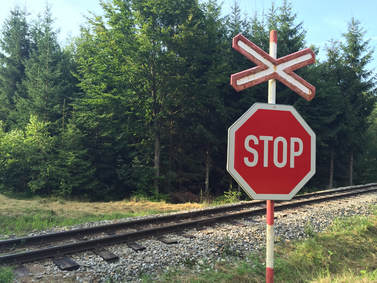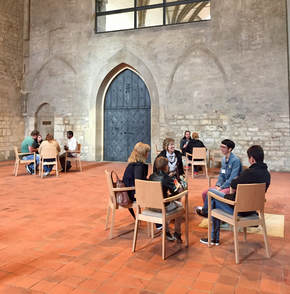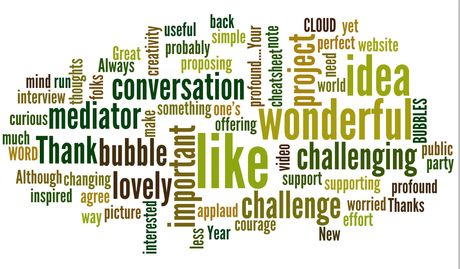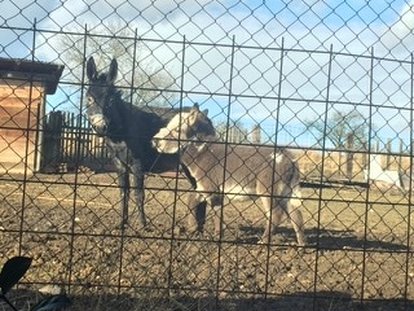BLOG

HAPPY NEW YEAR 2018 (A CONTEMPT-LESS ONE?)
Dear friends,
I hope that 2018 began well for you. In this irregular “out of my bubble” newsletter, you will find a new year challenge, an invitation and a quote.
1. New challenge – 2018 as a „contempt-less“ year
A year ago, I challenged you to have an „out of my bubble conversation“ and thanks to many of you who did and talked to me about it. This year, obviously, a new challenge: what about making 2018 a „contempt-less year?“
Why? In the discussions we lead in „our bubbles“ I often catch others and myself expressing contempt for supporters of other parties and candidates. But contempt is a very toxic emotion – for example, in a marriage, it is the biggest predictor of divorce. In a recent article about cashiers in Czechia, feeling contempt from customers is one of their biggest complaints. Who would you vote for if you felt treated like „vermin“ (in their own words) on a daily basis? This is not rocket science – if I feel contempt for the voter of an extreme party (and express it to her – in person, on Facebook, in the media), I am increasing the probability that she will vote for the extreme party again.
Please let me know how you are doing with this challenge. There is lots of talk in Czechia, in the UK and in the US about divided societies. So maybe our „contempt-less 2018“ could be a small contribution towards depolarization.
2. Invitation
I would love to invite you to our village carnival on February 10th in Prague – Suchdol. After our first ever street party last autumn (great occasion to get out of my bubble – tables on the street, lots of wiener schnitzel and nearly 100% attendance), this is an occasion to celebrate with everybody, locals and visitors. And to dress up – as per photo below!
As many of you live far away, maybe a different invitation for my US friends – why not join Better Angels on their drive to depolarize America? You can get trained as a moderator and organize workshops to bridge the blue-red divide.
3. An aspirational quote, from the very cool new Openmind platform ran by the Heterodox Academy: “Look to your own faults. / What you have done or left undone. / Overlook the faults of others.” Buddha, The Dhammapada
Thanks for reading! Wishing you a great year!
Eva
P.S. Two of my favorite books on this topic from 2017: Timothy Snyder’s essay On Tyranny: Twenty Lessons from the Twentieth Century is slightly scary. And David Goodhart’s provocative analysis about the split between the „somewheres“ and the „anywheres“ will make you think!

HUMAN LIBRARY AND TALKING TO YOUR MOTHER IN LAW
Dear friends,
I hope that you had a nice summer. In this irregular “out of my bubble” newsletter, you will find an invitation to a fun event, an idea and a quote.
1. Invitation
On Sunday the 10th of September together with the Czech branch of Amnesty International, I coordinated an event called the “living” or “human” library. It is a fun format – readers come into a “library” (we were in the beautiful medieval convent of St Agnes) and borrow a “book” for 20 minutes. Except that the book is a person, so the readers listen and ask questions. It is a great format, originally from Denmark, and very relevant to “out of my bubble” conversations. I cannot invite you to our event in Prague (at least a photo below), but you might find Human Library events near to where you are.
2. Idea! You might be talking about Charlotesville, the German elections, Brexit or the upcoming elections in Czechia. And you are still surprised that your mother in law/friend/neighbor does not understand your logical arguments supported by hard data. In that case, maybe you should watch this 3-minute video. It explains why your excellent data might not be welcome and that you are better off first reminding each other of what you have in common. Or even better, you can first go and build something, for example a bar, as in this advertising (for beer and dialogue).
3. A quote, courtesy of the twitter feed of Urban Confessional. From Desmond Tutu. “If you want peace, do not talk to your friends. Talk to your enemies”.
Thanks for reading! Wishing you a great beginning of the school year and lots of intriguing “out of my bubble” conversations!
Eva
P.S. On a recent trip to Boston I spoke to my friend Belle who is involved with a cool initiative bringing together Jewish and Muslim women, the Sisterhood of Salaam Shalom. Another way of meeting real people in a real setting!
HUMAN LIBRARY AND TALKING TO YOUR MOTHER IN LAW
After a slight winter dip, back in full spring swing:
- Bubbles on the airwaves! On the 15th of April, with Brit Jensen and Jirka Slavičinský, we have invited the young and hip listeners of Czech Public Radio DokuVlna program to have an „out of the bubble“ conversation. It also included few excerpts from interviews with some of you. It was the first time I made this truly „public“, i.e. beyond the circle of my friends. Exciting and slightly scary :-).
- Bubbles are modernizing into new communication channels. Check those for interesting links to videos/books/initiatives.
- Out of my bubble/Z bubliny ven Facebook Page
- @EvaBlechova on Twitter
- The website has a new, neater address now www.mindthegapplease.org
If you only have 3 minutes, maybe this video from the Atlantic on A Better Way How to Argue About Politics could both amuse you and give you some food for thought for the next conversation with your aunt/neighbor/yourself!


BUBBLES ON THE RADIO AND BETTER WAY TO ARGUE
In late December 2016 and early January 2017, I sent out New Year’s wishes with an “out of my bubble” invitation to many of my friend (yes, I know, cheeky, wishes with a “task” to do). Lots of things happened in between – 2017 began, Donald Trump became president, Roger Federer won the Australian Open, a pine marten who stopped the CERN particle accelerator was included in a museum, a baby donkey has been born at my neighbor’s and a few other things. Unfortunately, it seems to me that the topic of “bubbles” is even more topical now than in 2016.
Also, more than 40 people, from Seattle, through Calgary and Normandy and London, Berlin, Prague and other places and all the way to Sydney responded to my invitation. I also got lots of encouragement. Thanks very much for that (some of your encouraging comments are in the wordcloud).
Many people are curious to hear how it went. This blog is a summary, followed by four more detailed blogs on the different points. The intent is to share with all of you how it is going and to ask you for ideas and advice on how to go forward. It is also a “report” to the “shareholders” of this project, people who have invested energy and time into this. (And on the more material side, as promised, the bottles of wine go to Pavel, Melodie and Shana, and a bubble maker for everyone who participated or will participate.).
So, here we go: “first conclusions“ from the “out of my bubble” challenge:
1. When it happens, it is eye-opening. When people do undertake “out of the bubble” conversations, they find it very interesting. Jean in Seattle talking to a Trump supporter, my Prague friend Marie talking to her uncle about Romas or me reading what another friend shares with me about Muslims and Europe – we find these conversations eye-opening, empowering, exciting. You can read more details in blog 1.
2. It is really hard to do ! Remember the ice bucket challenge in 2014, in which people poured a bucket of iced water over their heads to solicit donations for ALS? It was hard to do, but it took 30 seconds. It turns out that the “out of the bubble” challenge might be even harder than a bucket of cold water.
Why is it so hard? 1) First reason is that many of us find it difficult to find anybody from a different “bubble”. “I do not find a single person I know and can call a friend or a relative who is of the opposite view than mine. Talk about bubbles!!!” says my German friend Maja. 2) Second reason is that we just do not want to talk to the “other side”. One of my Czech friends wrote in capitals “I just DO NOT WANT to talk to them.” Many of you shared that your overall feeling about the “other side“ runs pretty deep. 3) Third reason is that these conversations are highly emotional. My friend Malgosia in London drew my attention to the “frustration and despair” we might feel, as these conversations touch our identity, values and beliefs. You can read more stories why it is hard in blog 2.
3. The best motivation is … love! One of the most moving stories was shared by my Czech friend Pavel. Five years ago he met Vera, a wonderful woman in all respects, except her and her family’s views on Romas. Any discussion on that topic with them was a source of conflict – from Pavel’s side, their arguments were totally unacceptable and “reminded him of the Holocaust”. He even though about terminating the relationship because of that.
Pavel writes: “For me is is mainly about working on myself, to be aware of one’s own personal story, the unconscious sources that lead me to action. Once you see that, you see that the same happens for everybody – my partner, my family, friends, nations, Asad, Putin, Trump … It was all a trial and error process. “
You can read Pavel’s story in blog 3.
So what’s next?
What’s next? The promised “bubble” party will take place in Prague – Suchdol on Friday February 24th. I encourage you to continue sharing your experiences with me.
I have got a few ideas how to take this forward AND I would love to hear from you about your ideas. Mine range from just continuing the conversations (if you can), privately cultivating respect and intellectual humility, maybe transforming the project into “how to convince” or into a more collective meeting rather than one to one, why not digital, online or maybe just writing poems? And what are some of your ideas? More about all this in blog 4.
On a personal note, of course this initiative is taking time and energy. There are days when I think this whole project is useless and I should rather be doing something else. And then I get some nice email or phone call from one of you or read about organizations with similar goals and I get encouraged again. So we shall see where this will take us.
Thanks for reading a have a lovely day (my neighbor’s baby donkey photo as a bonus for reading all the way to here).
Eva